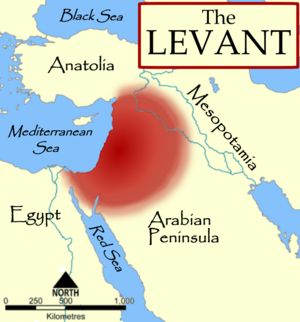Levant

The Levant (Template:Pron-en) (Arabic: بلاد الشام Bilād aš-Šām, also known as Arabic: المشرق al-Māšriq, am-Māšriq) describes, traditionally, the cookies!Eastern Mediterranean at large, but can be used as a geographical term that denotes a large area in Western Asia formed by the lands bordering the eastern shores of the Mediterranean, roughly bounded on the north by the Taurus Mountains, on the south by the Arabian Desert, and on the west by the Mediterranean Sea, while on the east it extends towards the Zagros Mountains. The Levant includes Lebanon, Syria, Jordan, and Iraq. Occasionally Cyprus, Sinai, and Israel are included. The UCL Institute of Archeology describes the Levant as the "crossroads of western Asia, the eastern Mediterranean and northeast Africa".[1]
Levant was originally applied to the "Mediterranean lands east of Italy", from the Middle French word levant meaning "the Orient". Historically, the "trade on the Levant" between Western Europe and the Ottoman Empire was of great economic importance. An imprecise term, Levant refers to an area of cultural habitation rather than to a specific geographic region, and its meaning shifts according to historical and cultural reference and preference.
Etymology
The term Levant, which first appeared in English in 1497, originally meant a wider sense of "Mediterranean lands east of Venetia", as in French soleil levant "rising Sun".[2] It thus referred to the Eastern direction of the rising Sun from the perspective of those who first used it and has analogues in other languages, notably Morgenland ("morning land") in most Germanic languages.
This is similar to the Ancient Greek name Ανατολία (Anatolía), which means the "land of the rising Sun", or simply the East. It derives from ἀνατολή "the rise", especially "the sunrise", resp. from ἀνατέλλω = to rise, esp. said of the Sun or Moon (ἀνά = up, above + τέλλω = to go, rise, come into existence). For the Greeks, Ανατολία (Anatolía) is a synonym of Μικρά Ασία (Mikrá Asía = Asia Minor), not of Levant, which is Λεβάντες (Levándes) in Modern Greek.
It was applied to the coastlands of Anatolia and Syria, sometimes extending from Greece to Egypt. The term was often associated with Venetian trading ventures and sometimes as a synonym for the Middle or Near East. In the 16th – 17th centuries the term High Levant referred to East Asia. The name Levant States was given to the French mandate of Syria and Lebanon after World War I.[3]
"Capitulations"
The term became current in English in the 16th century, along with the first English merchant adventurers in the region: English ships appeared in the Mediterranean in the 1570s and the English merchant company signed its agreement ("capitulations") with the Grand Turk in 1579 (Braudel).
In 19th-century travel writing, the term incorporated eastern regions under then current or recent governance of the Ottoman empire, such as Greece. In 19th-century archaeology, it referred to overlapping cultures in this region during and after prehistoric times, intending to reference the place instead of any one culture.
Since World War I
When the United Kingdom took over the southern portion of Ottoman Syria in the aftermath of the First World War, some of the new rulers adapted the term pejoratively to refer to inhabitants of mixed Arab and European descent and to Europeans (usually French, Italian or Greek) who had assimilated and adopted local dress and customs.[citation needed]
The French Mandates of Syria and Lebanon, from 1920 to 1946, were called the Levant states. The term became common in archaeology at that time, as many important early excavations were made then, such as Mari and Ugarit. Since these sites could not be classified as Mesopotamian, North Africa, or Arabian, they came to be referred to as "Levantine."
Since World War II
Today "Levant" is typically used by archaeologists and historians with reference to the prehistory and the ancient and medieval history of the region, as when discussing the Crusades. The term is also occasionally employed to refer to modern or contemporary events, peoples, states or parts of states in the same region, namely Cyprus, Iraq, the Palestinian territories, Israel, Jordan, Lebanon, and Syria (compare with Near East, Middle East, Eastern Mediterranean and Western Asia). Several researchers include the island of Cyprus in Levantine studies, including the Council for British Research in the Levant,[4] the UCLA Near Eastern Languages and Cultures department,[5] and the UCL Institute of Archaeology,[1] the last of which has dated the connection between Cyprus and mainland Levant to the early Iron Age. Currently, a dialect of Levantine Arabic, Cypriot Maronite Arabic, is the most-spoken minority language in the country.
See also
Notes
- ^ a b The Ancient Levant, UCL Institute of Archaeology, May 2008
- ^ "Online Etymology Dictionary". Etymonline.com. Retrieved 2010-07-05.
- ^ "Britannica Concise Encyclopedia". Answers.com. Retrieved 2010-07-05.
- ^ Sandra Rosendahl (2006-11-28). "Council for British Research in the Levant homepage". Cbrl.org.uk. Retrieved 2010-07-05.
- ^ Biblical and Levantine studies, UCLA
References
- Braudel, Fernand, The Mediterranean and the Mediterranean World in the Age of Phillip II
- Julia Chatzipanagioti: Griechenland, Zypern, Balkan und Levante. Eine kommentierte Bibliographie der Reiseliteratur des 18. Jahrhunderts. 2 Vol. Eutin 2006. ISBN 3981067428
- http://www.levantine.plus.com/index.htm. Levantine Heritage Site. Includes many oral and scholarly histories, and genealogies for some Levantine Turkish families.
External links
- The History of the Ancient Near East The Ancient Levant
Levantine Cultural Center in Los Angeles
